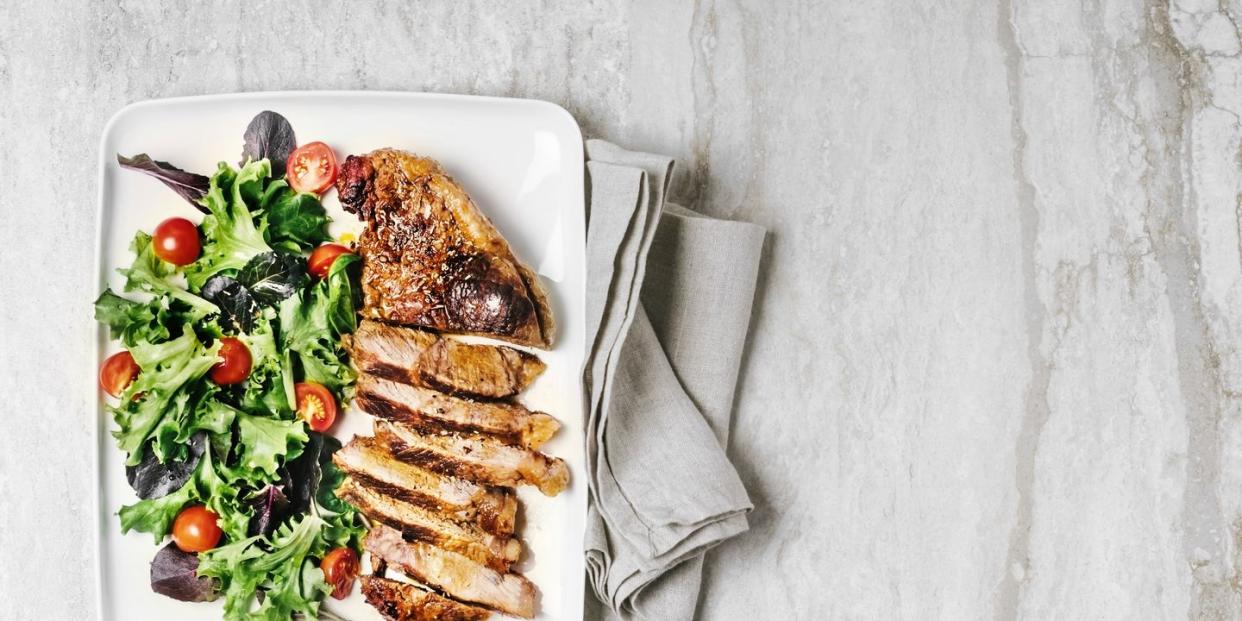Everything a nutritionist wants you to know about the vertical diet

If you're into the gym in a big way, specifically bodybuilding, you may already be familiar with a new eating plan that's gaining traction, known as 'The Vertical Diet'. We asked registered nutritionist and dietician, Susie Bond, from Health First, to explain whether or not the diet is safe, who typically does it and what foods are included.
What is the Vertical Diet?
The Vertical Diet was designed as a muscle-building, performance-based diet for bodybuilders. However, it's recently been marketed as a weight-loss diet for casual gym-goers. "For background, the diet was developed by pro powerlifter/body builder Stan Efferding to help build muscle and fuel athletic performance," says Susie. "To do this, the diet consists of nutrient-dense foods that meet the body's need for vitamins and minerals and easily digested carbohydrates for energy."
Why is it called the Vertical Diet?
The Vertical Diet is named as such because it's pictured graphically as an upside-down T. "Imagine that the base of the T is represented by foods rich in vitamins and minerals, and the vertical portion of the T is made up of red meat and white rice," notes Susie. Essentially, the basis of the diet is that it allows people to consume larger amounts of food without getting full, resulting in higher calorie consumption and more energy. It's also very heavily focussed on meat, so isn't suitable for vegetarians or vegans.
A post shared by The Vertical Diet (@theverticaldiet) on Jan 23, 2020 at 2:42pm PST
What can you eat on the Vertical Diet? And what foods are off limits?
"To follow the diet as written, a person would consume small amounts of a limited selection of foods daily, with the primary source of calories coming from red meat and white rice," explains Susie.
Foods you can eat on the Vertical Diet:
Red meat (the diet allows, but does not encourage, the consumption of chicken or fish)
White rice
Fruits
Potatoes (white or sweet)
Low-FODMAP vegetables (carrots, celery, cucumber, bell peppers, eggplant, etc.)
Oils and fats
Eggs
Dairy
Sodium
Oats (only if soaked and fermented)
Legumes (only if soaked and fermented)
Foods to avoid on the Vertical Diet:
Grains
Highly processed vegetable oils
Onions and garlic
High-FODMAP vegetables (broccoli, cauliflower, sprouts, kale, etc.)
Sugar alcohols
Added sugar
Coffee
A post shared by Alexis Rivera (@the_holistic_hipster) on Jan 13, 2020 at 4:41pm PST
What are the pros and cons of the Vertical Diet?
Fans of the eating plan say one major benefit is that it allows athletes to consume high amounts of calories and nutrients to increase energy, muscle growth and strength, without causing digestion issues. "However, the diet is extremely restrictive and doesn't allow room for all the necessary nutrients your body needs," adds Susie. "Many of which are essential for digestive health."
The cons include:
The Vertical Diet is highly restrictive: The diet limits the intake of other essential nutrients.
The Vertical Diet is rich in red meat: High consumption of red meat is associated with an increased risk of certain types of cancer, heart disease and diabetes. Health experts recommend limiting red meat consumption to three servings per week.
There's a lack of omega-3 fatty acids: The Vertical Diet does not encourage seafood and fish; therefore, it doesn't provide sufficient amounts of omega-3 fatty acids, which are necessary nutrients to keep the human body functioning effectively.
A lack of gut health support: "Our gut relies on prebiotics and probiotics, which are substances found in foods such as oats, onions, whole grains, asparagus, apples and fermented dairy products – all of which are strictly limited in the Vertical Diet," says Susie. “The Vertical Diet claims to help athletes with gut health, because it includes high amounts of white rice, which is an easily digested carb. However, while white rice is easily digested, the diet is restrictive and lacks fibre, and foods such as lentils and broccoli, which are essential for digestive health and function.”
It's Not Vegan or Vegetarian-Friendly: The Vertical Diet is not able to be adapted to vegan or vegetarian diets.
How long should you be on the Vertical Diet for?
"The Vertical Diet is more of a short-term, performance-focused diet, not necessarily a lifestyle change," says Susie. "It's important to note that the main reason people follow it is to support muscle growth and digestion in bodybuilders." Bodybuilders, weightlifters, and athletes see the diet as a way to increase calorie consumption, but maintain gut health, on a temporary basis.
Is the Vertical Diet dangerous?
"Generally speaking, the Vertical Diet is highly restrictive and doesn't allow for enough of the nutrients your body needs to stay healthy," says Susie. "The diet places a focus on red meat as the primary source of your protein, but high red meat consumption is linked to heart disease, some cancers, kidney problems and digestive issues." Overall, a more balanced and nutrient-rich diet is a healthier option for the average gym-goer.

How do you know if the Vertical Diet is right for you?
"Depending on the individual's nutritional needs, the Vertical Diet can be helpful for bodybuilders, competitive weightlifters and athletes that need to support muscle growth," notes Susie. "It could be useful to people looking to lose weight – but there are healthier diets that can help someone lose weight that don't cut out so many beneficial nutrients."
Like this article? Sign up to our newsletter to get more articles like this delivered straight to your inbox.
You Might Also Like

